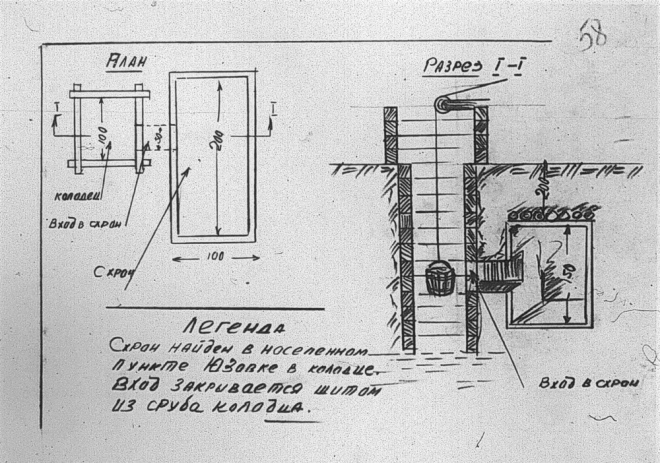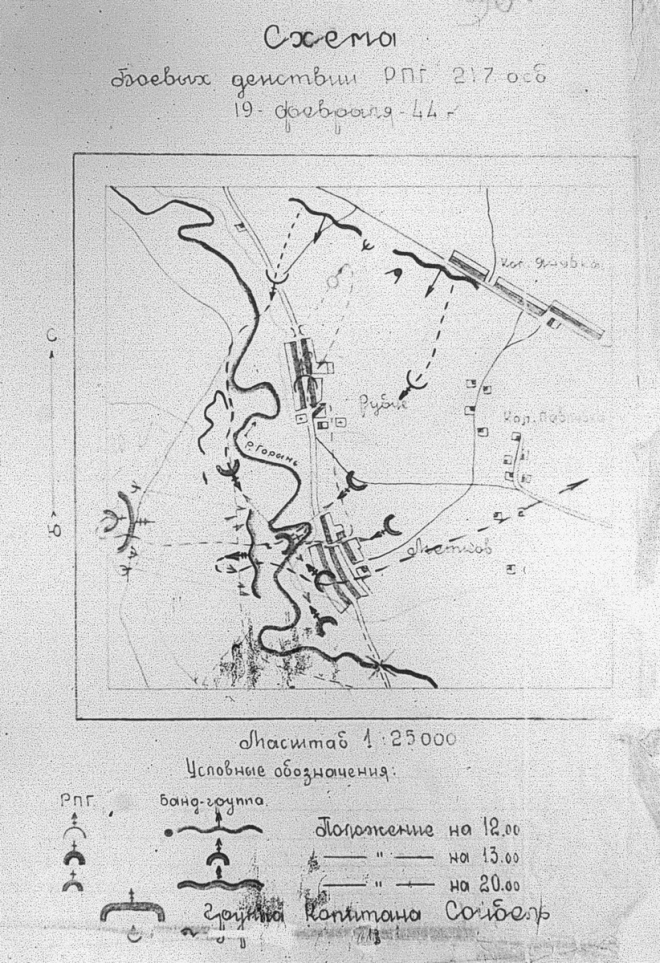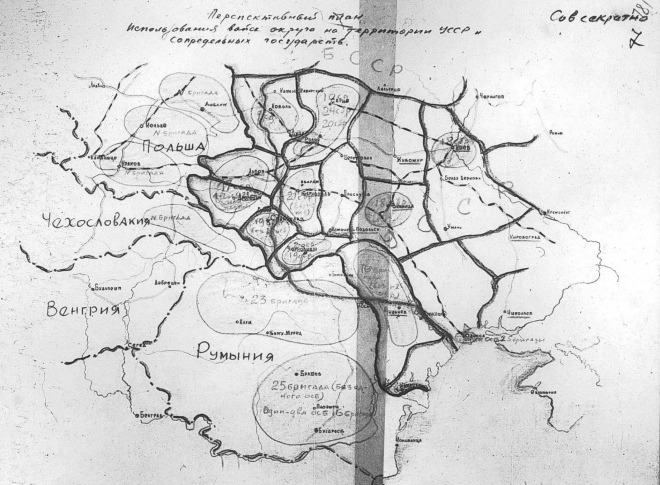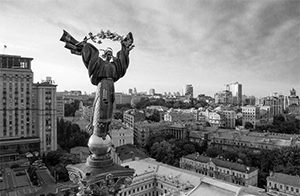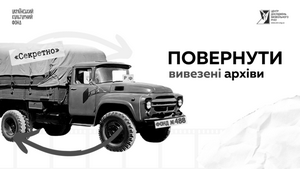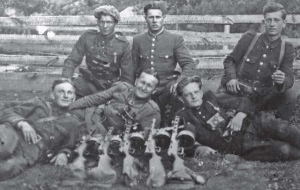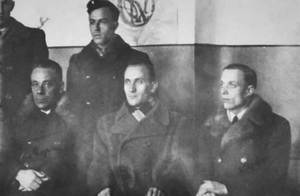Making the Past Accessible: How Ukrainian Scholars Returned the Taken Archives of the NKVD
A detective story about how more than 400 NKVD files on combating Ukrainian guerillas were taken away from Ukraine in late 1980s and who and how manages to bring these records back.
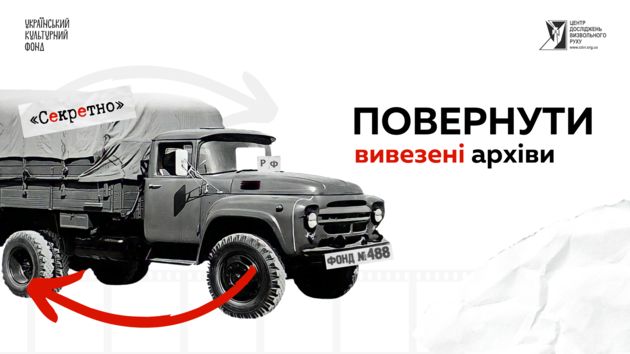
This summer, the Center for Research on the Liberation Movement began to publish documents from the NKVD Internal Troops of the Ukrainian District Archive online, and by the end of October, they made about 3,500 documents accessible.
One can find there dugout schemes of the OUN and the UPA, reports on clashes between NKVDists and insurgents, instructions and orders of the NKVD Internal Troops High Command given downside and reports in reverse direction.
We present a detective story about how more than 400 NKVD files on combating Ukrainian guerillas were taken away from Ukraine in late 1980s and who and how manages to bring these records back.
What the NKVD Internal Troops Were and What They Recorded in Their Documents
Not only did the Soviet Union wage warfare on the frontline, but also in its rear attempting to search and destroy the so-called enemy from within. Millions had their fair share of being enemies of the Soviet State during the last century: from the Communists' political rivals to representatives of national resistances, and even their old parents and little children. In different times, the Soviet authorities obliged various repressive bodies to find out and eliminate domestic adversaries.
At the point of 1943—1944 in the course of the Second World War when the frontline went to the West and the Red Army entered the western territories of Ukraine for the second time, the Soviet power faced strong resistance — the Organisation of the Ukrainian Nationalists and the Ukrainian Insurgent Army.
"The Red Army regular forces were not always efficient in suppressing this movement," comments Ivan Patryliak, a historian and Ukrainian Liberation Movement scholar. "They were too cumbersome for counter-insurgency. Quite often soldiers had little desire to participate, yet they quite easily yielded to the insurgent agitation."
Therefore the duty to fight Ukrainian insurgents was entrusted to the soldiers of the NKVD Internal Troops (VV NKVD), the units that had been fighting at the rear, not at the front. In March 1944, the VV NKVD Headquarters of the Ukrainian District was established in Rivne, and that was the starting point in the history of the archive which is published in open access now.
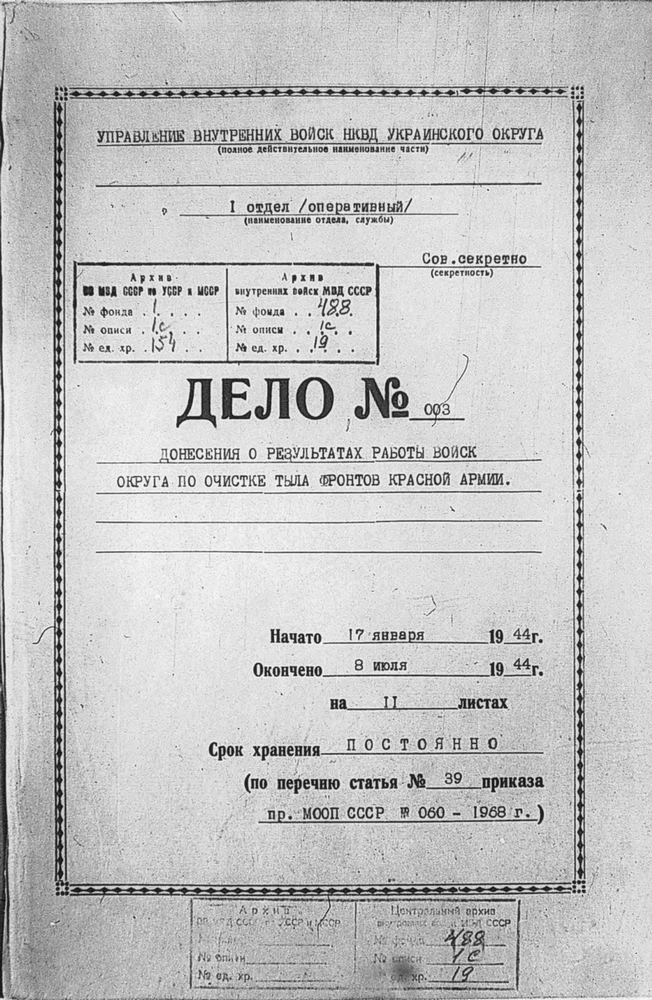
The published corpus covers the period between 1943 and 1952, although the majority of documents are dated 1944—1945. There is information about events in Volynia, Rivne, Ternopil, Lviv, and Ivano-Frankivsk regions. Zhytomyr, Khmelnytsky, Vinnytsia provinces, as well as current Romanian and Poland, are less common.
"The principal armed force on the USSR side that engaged the UPA was the NKVD Internal Troops. Thus, we are talking about records of the very military units that ambushed, raided, blockaded towns and villages, that is waged warfare against the Ukrainian insurgency," says Andriy Kohut, the Director of the Security Service of Ukraine Archives and the Project Expert.
Dugout sketches, insurgent interrogation records, reports of executed operations, their analysis, statistics are among these 3,500 of papers. All these are, no doubt, significant historical sources.
"When the Internal Troops' records are digitalized and published and scholars as well as all people interested are able to inspect them, this will help to compare and analyse how this 'war after the war' looked like from both sides ― the guerilla and the Soviet," explains Kohut.
The Russian Trace
"When Ukraine gained its independence 30 years ago, all rallies and demonstrations resounded with claims that archive documents and special fonds had been moved from Ukraine to Russia. To some extent it was true," remembers Oleksandr Vovk, formerly a junior research fellow at the Institute of Ukrainian Archeography and Source Studies.
The fact of taking records away massively from Ukraine just before the collapse of the Soviet Union has not been documented yet. Nevertheless, moving of the NKVD Internal Troops Archive was.
Information on digital copies of the documents tells its whereabouts. Originals from which these copies were made had allegedly been stored in the Internal Troops of the Ministry of the Internal Affairs of the USSR Archive. That is reasonable ― this was the agency the NKVD Internal Troops were subordinate to. So we may assume that the paper original of the archive is in Moscow.
These files, like all records of central subordination, according to Oleksandr Vovk, did not legally belong to Ukraine. They were stored in Kyiv just for the purposes of secret services. "They had been in Kyiv since the 1950s, and nobody from Moscow demanded them," the historian explains. "Although the struggle against the liberation movement had been still in action here, the documents were housed in Kyiv for the operational service. And they were to be transferred to Moscow by instruction."
The researchers suppose that the archive remained in Ukraine until the late 1980s. How and when the documents were moved nobody knows for certain. There is no documentary evidence of this event in Ukraine. At least, they had not been found neither in the Central State Archives of Supreme Bodies of Power and Government of Ukraine, nor in the Ministry of the Interior Archives. "It seems like some apparatchik in the State Security, apparently some 'homo sovieticus', fulfilled his duty and gave these records away. Though it was possible to withhold them by fait accompli when Ukraine became independent," assumes Vovk.
Only information from cover pages of the copies made by researchers attest to the originals' location in Moscow. "Currently, these documents are not in open access. I tried to find out where, at all, they are housed. But failed to come across such information," admits Andriy Kohut.
So, who can tell, whether we would once obtain access to crucial information locked up by Russian legislation, were it not for the mysterious operation of copying and returning the archive to Ukraine.
Operation "Return"
Although they stood a good chance to stay classified as "top secret" for decades, 400 files from the NKVD Internal Troops Archive about the struggle between the Chekists and the Ukrainian insurgents, after all, came back to Ukraine — in the shape of filmed copies. Still, like with their disappearance, the story of how it became possible to make those copies was not documented.
To recover the sequence of events and learn the names of scholars who brought the archive back to Ukraine, we made inquiries to major authorities who could have possessed the needed information: the Security Service of Ukraine, the Ministry of Internal Affairs, and the Cabinet of Ministers. Each time the response was: the archives contain no records about the requested events.
As far as we know for sure, the return was initiated and, in fact, executed by the archivist and the Ukrainian Liberation Movement researcher Anatoliy Kentiy. In the early 1990s, he worked at the staff of the Main Archive Administration of Ukraine. Historian Oleksandr Vovk used to work together with Kentiy later in the Central State Archive of Civic Associations and it was Kentiy from whom he heard a story of document collection taken to Russia.
According to him, Anatoliy Kentiy was allowed to work with the documents as early as in the 1980s: "The Party needed people who would be qualified enough to write something. That's why in the 1980s he was among the first ones to be granted a narrow admittance to the documents. Actually, he knew about this fonds, because he had seen it out of the corner of his eye. And he received a message that these records had been transmitted to Moscow."
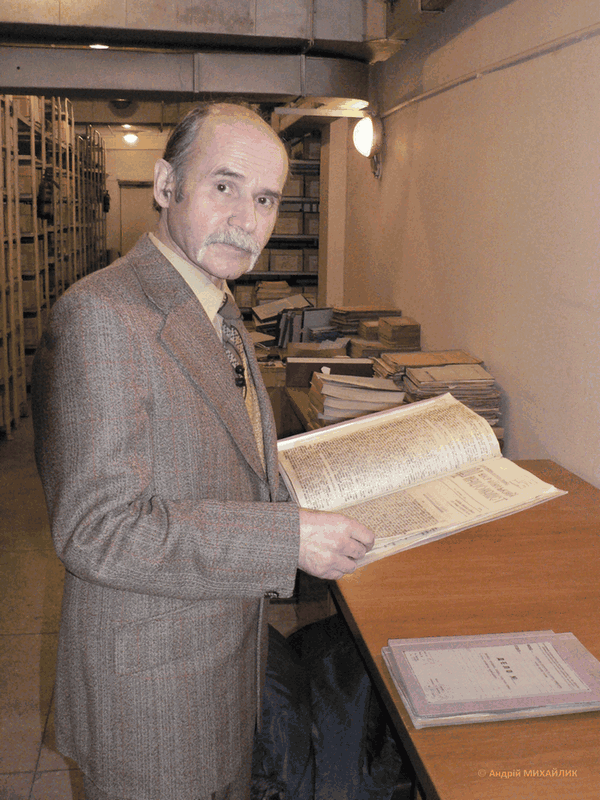
With the perception where the archive was located Anatoliy Kentiy enlisted the support of then management of the Main Archive Administration. And they, in turn, filed an inquiry to the Cabinet of Ministers. As a result, the archivist supported by the Ukraine's Government managed to make a business trip to Moscow and get permission to work the archive up. "At that time Moscow was a mess, and they would give access anywhere," Vovk explains such a window of opportunity from Russia.
Later governments of both countries signed an agreement. Under its terms Kentiy was allowed to copy information about the struggle of the NKVD troops against the UPA, but at the same time personal data of the Internal Troops servicemen, lists of troopers' names for instance, had to stay in Russia. "The Ukraine Government paid, I guess, 30 million rubles for these records (the figure might be incorrect — Editor's note)," says Oleksandr Vovk.
That is how Anatoliy Kentiy made microfilm copies of about 400 files. It was the form of films that documents had when they arrived in Ukraine.
And What Was Next?
The story of the returned NKVD Internal Troops Archive does not end here. Today, there are three copies of these files.
The copy made in Moscow was brought by Anatoliy Kentiy to the Main Archive Administration. Later it found itself in the Central State Archive of Supreme Bodies of Government and Administration and still has been stored there.
Yet beside this researchers made two other duplicates of the films. "Representatives of the Litopys UPA Publishing House came to Ukraine from Canada. An agreement on joint studies and search for documents related to the liberation movement was then signed between them and the Institute of Archaeography," recalls Vovk. "After that the Litopys UPA granted funds to the Main Archive Administration under the condition that copies would be made from the VV NKVD Archive duplicate".
Professor Peter Potichnyj was in the 1990s the editor in the publishing house and he remembers those events well: "We asked how we could obtain copies of those records and got a response that they would try to have copies for us while making them for Ukraine," recalls the historian.
The publishing house found a donor to pay for making copies, and after that received permission to transport the duplicate of the archive to Canada. "It was good that I enlisted the support of the Canada's ambassador," says professor, "Because when I underwent the customs control with these documents, the officials told me: maybe you have to leave these records here, you need additional special permits which you will receive with our assistance". The films, eventually, were shipped to Canada.
Peter Potichnyj recalls: at first nobody in Canada wanted to accept documents shipped from Ukraine. Because they needed to be worked up and professionally inventoried. The University of Toronto agreed to accept the archive because the historian was employed by the educational institution and managed to prove the legal status of the films he brought. Nowadays they have been still deposited in the Peter J. Potichnyj Collection on Insurgency and Counter-Insurgency in Ukraine, although they are for obvious reasons almost beyond the reach of Ukrainian scholars. To work with the documents one has to go directly to Toronto.
As the professor says, scientists from Europe and the USA have already worked with a part of these records, and the Litopys UPA used them in a number of their books and particularly in ones about dugouts and bunkers of the Ukrainian guerillas.
Later another copy of the filmed files which had been handed to the Centre for Research on the Liberation Movement was found. "Thanks to the popular now 'Force of the Facebook' the organisation crowdfunded for the appropriate equipment—a special scanner that can digitalize images from these films," remembers historian Ruslan Zabily.
It was possible to continue the work on arranging and inventorying archive documents thanks to the support of the Ukrainian Culture Foundation. Over 3,000 documents accompanied with detailed inventories are going to be published in co-operation with the UCF. Before long, the huge corpus of documents will be accessible for everybody just in a few clicks.
"These documents are the unique source that creates the opportunity for very thorough reconstruction of 1940—1950s events in Western Ukraine. Intensive and large-scale actions of the NKVD Internal Troops—the punitive organs of the Communist regime, recorded here, leave no doubt about mass character of the Ukrainian Liberation Movement they confronted, about self-sacrifice of the Ukrainian insurgents and enthusiasm of the local population in their fight for freedom," emphasizes Volodymyr Viatrovych, a student of the Second World War and the UPA.
It is unknown whether Ukraine will ever manage to return the paper original of the taken archive. So is, whether the "disappearance-return" story could ever be puzzled out more clearly than we can do now. Nevertheless, the free online access to this archive is already a successful example of returning to Ukraine what amplifies the pages in her history.
The article was prepared and published within the project "Making the Past Accessible: Digital Return of Removed Archives on the Struggle of the USSR Against the Liberation Movement", which is implemented by the Center for the Research on the Liberation Movement with the support of the Ukrainian Cultural Foundation.
